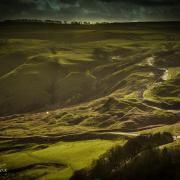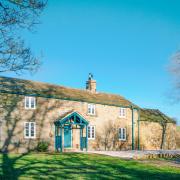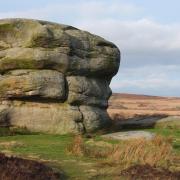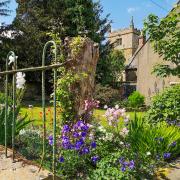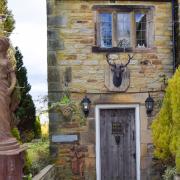Beautiful villages, famous towns, iconic scenery… the High Peak in Derbyshire has something for everyone.
Covering around 208 square miles, the fact that large swathes of the High Peak are owned by the National Trust gives an indication as to just how rich and beautiful this Derbyshire district is.
The most north westerly of our county’s districts, this area of outstanding natural beauty is bordered by just one other Derbyshire district – the Derbyshire Dales.
A Derbyshire crown jewel, the High Peak nevertheless has many touch points to other counties and areas outside our county – including South Yorkshire, the Staffordshire Moorlands, Cheshire and Greater Manchester.
The High Peak borough as it appears today was created in 1974, comprising former districts including Buxton Municipal Borough; Chapel-en-le-Frith Rural District; Glossop Municipal Borough; New Mills Urban District; Tintwistle Rural District; and Whaley Bridge Urban District.
With a population of just over 90,000 residents – as per the last census - local administration comes in the form of High Peak Borough Council, which carries out the majority of its administration duties from Buxton and Glossop.
It’s almost impossible to not be inspired and uplifted by the High Peak.
From the heather-clad moors of Kinder, the gritstone tors of Derwent Edge, celebrated towns and villages such as Buxton, Glossop, Castleton, Edale and Hope (to name just five) and breath-taking and iconic natural monuments such as Mam Tor and Kinder Scout, the High Peak is, quite simply, a stunning part of our county.
READ MORE: How to spend a day in Buxton in Derbyshire
Much of the district, unsurprisingly, falls within the Peak District National Park and in Kinder Scout, the High Peak boasts Derbyshire’s highest point – Kinder Scout – which stands at an imposing 2,000-plus feet above sea level.
The High Peak Trail, which runs for 17 miles from Dowlow, near Buxton, down to High Peak Junction in Cromford in the Derbyshire Dales and was once the route of one of Britain’s first railway lines, is a wonderful traffic-free route and an ideal way to take in some of the glories of the area.
Nowadays, locals and visitors alike are free to roam much of the Dark Peak and take in the stunning scenery this part of the county is so renowned for.
This isn’t something to take for granted, though. In 1932 the Mass Trespass of Kinder Scout took place, with protesters rebelling against the lack of opportunity to roam free on the moors for leisure purposes – much of which was in the control of landowners who could deny public access.
While estimates vary, what is certainly true is that hundreds approached Kinder Scout on April 24 1932 to make their feelings – and presence – known.
Whilst some protesters were arrested, the day resulted in a greater awareness of the ‘right to roam’ and the perceived injustice of effectively closing off huge portions of the countryside to the public.
The Mass Trespass continues to be commemorated to this day.
5 PLACES TO VISIT

Glossop
A north-western gateway to the Peak District and all its associated natural gifts, Glossop is a fascinating mix between the old and new. Built on the cotton industry, ‘Old Glossop’ dates to the 12th century and benefits from beautiful architecture and nods to its prosperous past.
These days, Glossop is a vibrant market town with a bustling High Street which is home to numerous independent stores.
Glossop also has a growing reputation as a haven for quality food and drink, showcasing fabulous local products as well as cuisines from around the world.
Its location at the foot of Snake Pass also means one thing – you’re surrounded by stunning countryside.
READ MORE: The best places to visit on a short break in Glossop
Chapel-en-le-Frith
Chapel-en-le-Frith, like Glossop, benefits from its wonderful location, nestled within the dramatic landscape of the Peak – Eccles Pike for example, a popular summit for walkers and photographers to ascend, is just a short walk from the town centre.
This lovely, picturesque and community-focused town is known colloquially as the ‘Capital of the Peak’ due to the fact that it was once an administrative centre having been built up around the Church of St Thomas Becket in the early 13th century.
Whilst you’re there, why not take advantage of the free Old Town Trail, a self-guided walk which takes in Chapel’s historic and interesting centre which is rich in heritage.
Whaley Bridge
The ‘gateway to the Goyt Valley’ (a designated Area of Outstanding Natural Beauty), Whaley Bridge made national headlines in August 2019 when over 1,000 residents were evacuated after heavy rain resulted in the spillway of a dam at Toddbrook Reservoir partially giving way, creating the very real possibility of the town being flooded.
Disaster was, thankfully, everted and a multi-million-pound permanent repair project continues.
Popular amongst walkers for its stunning location at the head of the Peak Forest Canal, the town itself is vibrant – known for its array of independent stores, traditional pubs and cafes and restaurants as well as a thriving music and arts scene.
READ MORE: Exploring the Goyt Valley from Whaley Bridge to Errwood
Hayfield
It was here, in the small village of Hayfield, that the aforementioned Mass Trespass began, with the village situated at the foot of the county’s highest peak.
Like many towns and villages in the High Peak, Hayfield offers wonderful accommodation options for visitors and an array of traditional pubs, shops as well as a popular art gallery.
The birthplace of Arthur Lowe, much-loved for his iconic role as Captain Mainwaring in Dad’s Army, Hayfield is well connected to other picturesque High Peak settlements – notably via the Sett Valley Trail, a flat two-mile route which links to the village to New Mills.
Hayfield is also famous for its popular Country Show and Sheepdog Trials.
READ MORE: Exploring the High Peak village of Hayfield
Castleton
A village often celebrated within the pages of this magazine, Castleton attracts visitors far and wide on account of its incomparable surrounding landscapes and the pull of its picture-postcard centre, famed for its community events - not least its Christmas light displays.
You don’t need to wait until winter though to take in all this glorious place at the western end of the beautiful Hope Valley has to offer.
Castleton is an outdoor lover’s paradise – show caves, rock climbing and landmarks such as Peveril Castle are just a few of the tantalising propositions on offer.
Castleton’s one of the Peak District’s most popular spots, and a visit makes it easy to see why.
READ MORE: Peak District walk: Castleton, Peveril Castle and Cave Dale
4 OF THE BEST

Castleton’s caves
Castleton and its surrounding areas are home to four impressive show caves which are open to the public – Peak Cavern; Speedwell Cavern; Treak Cliff Cavern; and Blue John Mine.
Of the four, Peak Cavern is the only one which is completely natural and as such is the least commercialised.
All four offer something a little different and each is spectacular and awe-inspiring in its own right. It’s worth checking ahead of time to see which suits you best.
Peak Cavern has the distinction of being the largest natural cave entrance in the whole of Britain whilst, as the name suggests, the Blue John Cavern is home to veins of the rare and beautiful Blue John mineral.
More details available at visitcastleton.co.uk/the-caverns.
READ MORE: 4 mysterious cave locations to visit in Derbyshire
Ladybower
It’s hard to imagine that two villages – Derwent and Ashopton – once stood at the bottom of what is now a vast reservoir, both of which were sacrificed during its creation in the 1930 and 1940s.
Nowadays, Ladybower, the lowest of three reservoirs in the beautiful Upper Derwent Valley, is a popular tourist attraction in its own right, given its tranquillity, wildlife, stunning scenery and walking routes.
Together, the Howden, Derwent and Ladybower reservoirs span some 210 hectares – the largest expanse of water in the Peak District.
Ladybower makes the perfect family day out – take a picnic, pick a walking route and take in the gorgeous surroundings. Don’t forget to take your camera with you, some of the views are simply wonderful.
READ MORE: Peak District walk - Ladybower
Bugsworth Basin
Continuing the water theme, Bugsworth Basin on the Peak Forest Canal, close to Whaley Bridge, is a lovely spot to watch the world go by.
Bugsworth Canal Basin was once the largest and busiest inland port on the narrow canal system and is the only one that still remains intact today.
Naturally popular with boaters, there’s still plenty to do on dry land and it’s the perfect place to go for a ramble.
Refreshments are available and there’s even a small visitor centre and museum at the site, run by the Bugsworth Basin Heritage Trust. Time it right, and you just might stumble across one of their numerous local events too.
It has a 4.5 out of five rating on TripAdvisor, with over 100 reviews submitted.
READ MORE: Peak District walk - Bugsworth Basin to Eccles Pike
Mam Tor
A right of passage for anyone passionate about the Peak District, Mam Tor is without doubt one of the Peak’s – and by extension the High Peak’s – most iconic landmarks.
Mam Tor translates to ‘Mother Hill’, whilst this imposing landmark is also referred to as the ‘Shivering Mountain’ given its history of regular landslides.
One aspect that makes Mam Tor popular is that, despite its height (517 metres) it’s relatively easy to climb to its summit.
And from here, the hiker’s efforts are rewarded. Expansive, majestic views incorporate the whole of the Hope Valley on one side and the Edale Valley to Kinder Scout and the Derwent Moors on the other.
There’s much to explore too – Mam Tor’s Great Ridge is almost two miles in length.
READ MORE: The easiest way to view the sunrise at Mam Tor
THE LOCAL VIEW
As lucky High Peak residents, my wife and I live in a thriving community surrounded by fabulous countryside.
Like other towns in the area, Chapel-en-le-Frith has long-established customs, independent shops and numerous places where we can eat, drink and socialise.
At Buxton, five miles away, we can visit art exhibitions, see plays, films and attend festivals. We enjoy going to High Peak bookshops where we can browse at leisure and we travel frequently to nearby hills to appreciate the extensive views from their summits.
As Dr Johnson said of London, anyone who tires of the High Peak is tired of life.
- Mike Smith, Derbyshire Life contributor
THE BUSINESS VIEW
High Peak Business Club brings the area’s diverse business community together and is open to anyone living or working in the High Peak or nearby.
It is independent, is not affiliated to any organisation and receives no funds from outside bodies.
Monthly meetings and talks take place at Chapel Frith Golf Club, Manchester Road, Chapel-en-le-Frith.
The D2N2 Growth Hub is also a significant source of bespoke business advice and support for businesses situated within the High Peak, with a clear purpose of helping these local businesses achieve sustainable growth and success to aid the local economy.
PROPERTY
Properties in High Peak had an overall average price of £295,929 over the past year, according to Rightmove, the UK’s largest online real estate portal and property website (rightmove.co.uk).
The majority of sales in High Peak during the last year were terraced properties, selling for an average price of £225,092.
According to Rightmove, semi-detached properties sold for an average of £285,147, with detached properties fetching £491,713 on average.
Overall, sold prices in the High Peak over the past year were 12% up on the previous year and 18% up on the 2020 peak of £250,772.
HIDDEN GEM

Alport Castles
If it wasn’t for the fact that it competes with so many other natural High Peak landmarks, Alport Castles may garner more attention than it does.
The striking appearance of Alport Castles, found on the eastern side of the Alport Valley, is the result of what is believed to have been the largest natural landslide in Britain.
The result is a landslip feature over half a mile long, with many of the mounds and debris giving the impression of a number of castles on the horizon.
A particularly prominent feature is ‘The Tower’, which one could almost mistake for a ruined fort.
Perhaps not as well known as neighbouring areas, there’s much to enjoy here – including the magnificence and force of Mother Nature, far-reaching views and even the potential for spotting peregrine falcons.
A word of caution, though. The rocks, as you’d imagine can be unstable so walkers should stick to designated rights of way.
READ MORE: Alport Castles - a hidden gem in the Peak District









